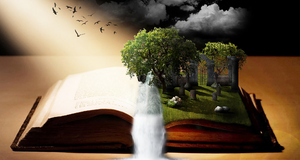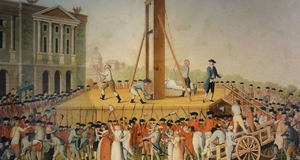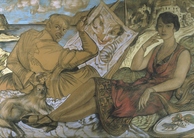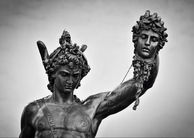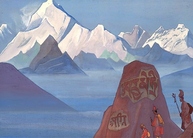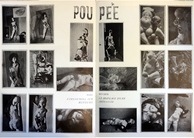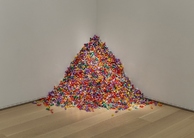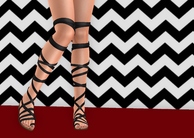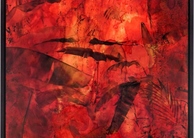Featured Article:"Every Place in the World on the Same Level!": Examining the Display of Non-Western Art at the Musee du Quai Branly
By
2010, Vol. 2 No. 03 | pg. 1/1
IN THIS ARTICLE
KEYWORDS
The Musée du Quai Branly opened under the long shadow of the Eiffel Tower in 2006 to spectacular criticism. Initiated primarily at the behest of then-President Jacques Chirac (b. 1932, held office from 1995-2007), the museum possesses an eclectic family tree, a complex history, and a controversial curatorial practice. Built to house the majority of France’s comprehensive collection of non-Western art, the museum stemmed not only from Chirac’s deep interest in non-Western art,1 but has origins in two previously established museums and gallery spaces devoted as well to non-Western art. These spaces, the former Musée de l’Homme and the Pavillon des Sessions in the Louvre, are both worthy of note in their own right and create a genealogy that leads toward the Musée du Quai Branly, shedding light on the story of how non-Western cultures are displayed in France. The following paper will examine the way France has displayed “the Other.” I will begin by outlining three elements that I consider “museum makers” in the French context—characteristics of the French identity that are foundational to the way in which French museums are structured. Okuwi Enwezor, artist and critic, writes about the “location” of any given curatorial practice: Curatorial and exhibition systems are confronted with the fact that all discourses are located, that is, they are formed and begin somewhere, they have a temporal and spatial basis, and they operate synchronically and diachronically. The located nature of cultural discourses, along with their history of discontinuities and transitions, confronts curatorial practices with the fragility of universalized conceptions of history, culture, and artistic procedures.2In context, Enwezor’s insight pertains to the Tate Modern’s curatorial practices, but it can also be used to elucidate the curatorial systems of the three spaces dedicated to non-Western art. The “location” of the French curatorial practice as pertains to non-Western art can be found in three things: the national identity that was created in 1789 with the French Revolution, the republicanism that also sprouted from the Revolution, and colonialism. I will then examine the museums that have been created around these elements. These three display spaces each approach non-Western cultures in a different way, creating a history of display textured with colonial ideologies, ethnographic study, and the coolness of pure aesthetics. I will look at the Musée de l’Homme, opened in 1937, and the strictly ethnographic approach it took to the display of non-Western art until it closed in 2004 for reorganization. I will then move to the Pavillon des Sessions, a small set of rooms that opened in the Louvre in 2004, where non-Western art was viewed from a singularly aesthetic point of view. I will end with the Musée du Quai Branly, opened in 2006, which offers a vague amalgamation of both presentations. Viewing the three spaces from a linear perspective, one might imagine some semblance of progress. Indeed, as will be explained throughout, it can be argued that each museum was built in an attempt to ameliorate issues or concerns with the previous setting. Given the globalized world in which we now live, where information is available to achieve an accurate and honest understanding of another culture, one might assume that the way a museum director of the 1930’s viewed non-Western art must be radically different from the way someone at a museum today would view similar content. However, I will contest that these three French exhibition spaces prove this assumption difficult to verify. Both criticism and support have descended upon the Musée du Quai Branly since its opening Despite the idea of evolution behind the disbanding of the former and outdated Musée de l’Homme and the creation of the Pavillon des Sessions and the Musée du Quai Branly, I will argue that France has not progressed in the way it presents non-Western cultures. The Museum MakersRepublicanism and National Identity Since the opening of the Louvre in 1793, Republicanism has largely defined the way French museums display their content. The opening of the Louvre to the public heralded a new beginning for the country, one in which the modern republican values of liberté, égalité and fraternité (liberty, equality and brotherhood), would be espoused through public access to the riches of France. Art historian Carol Duncan explains that, in being “open to all” as a public institution, the museum both created and reflected a national identity. “Now presented as public property, [the objects displayed] became the means through which a new relationship between the individual as citizen and the state as benefactor could be symbolically enacted.”3 The majority of the collection of the Louvre was compiled during Napoleon’s pillage-and-plunder campaigns across Europe and the Middle East, some of which were advertised as scientific expeditions.4 Not only was the French citizen united in free access to this collection, but he was to see the power of his country in it as well. Duncan goes on to explain that for other dominant, Western countries looking to the Louvre as a model, the opening of a museum was a safe and relatively easy way to assert national power; citizenship could be conferred without also have to relinquish the central power of the government.5 The opening of the Louvre was a nation-building project. The republican values of liberté, égalité and fraternité were first introduced in the Declaration of the Rights of Man and the Citizen, drawn up in 1789 as the constitution that established the country’s new laws.6 This decree gave ultimate rights to the citizen, rather than to the individual, allowing, for instance, access to the Louvre for all members of society despite their social rank. The term “citizen” was the ultimate equalizer. However, since citizenship was the main factor for equality, this meant that particular religions, ethnicities or languages—common marks of individuality—were explicitly different from the characteristics shared as a citizen of France, and were thus not allowed to be publicly acknowledged.7 In her essay “Cultural Difference and Cultural Diversity: The Case of the Musée du Quai Branly,” Nélia Dias offers an explanation of French citizenship in this regard: The notion of [French] citizenship implies the sense of belonging to This preference toward citizenship and universality makes the topic of cultural diversity and cultural difference, and especially the portrayal of such diversity and/or difference in a museum, particularly complex and intriguing. Under the umbrella of French citizenship, the concept of égalité (previously described as “equality”; Dias translates this as “equivalence”9) purports that in theory, all cultures and religions are equal. Likewise, laïcité, the French version of secularism, works similarly to égalité in that publicly, no religious belief can be given a preference over another. As Séverine Le Guével, head of international relations at the Musée du Quai Branly, offered to anthropologist Sally Price, We at the Quai Branly…respect the principle of laïcité. Therefore, we do not take into consideration any claim based on religion or ethnicity…We’re a public institution, a secular institution operating in the public domain. If you allow the legitimacy of one religion, you allow them all, and then they cancel each other out. That would put every place in the world on the same level!10 One is therefore free to do as one pleases on one’s own terms and in private, but in the public sphere, everyone must adhere to the universality of the republican values—even though this “universality” only seems to adhere on the state level, and not on an individual level.11 This inclusive/exclusive value system plays out most interestingly in the creation of a museum of non-Western art, which we will see later. Colonialism The French colonial mission civilisatrice, extending from roughly the 1850’s to 1930, was motivated by the idea that “primitive” cultures needed “saving” and/or “cultivating” in the image of the French in order to be civilized. The history and effects of French colonialism play an integral role in how non-Western cultures are presented today. The phrase “nos ancêtres les Gaulois,” which was commonly taught to children of colonized countries, was meant to draw every person who “believed” it under the umbrella of “French” by evoking ancient French roots.12 France was essentially attempting to create an identity for a community of people united only through a forced political bond.13 The mission civilisatrice also established France as an important imperial power, as it joined ranks with other European countries who had implemented colonial projects. It thus influenced the way the earliest French ethnographic museums chose to interpret non-Western cultures, which in turn shaped the way the Musée du Quai Branly approaches the same content. Building off of its republican and universal values, the French attempt to convert, assimilate, and integrate Africans, Algerians and other non-Western cultures was essentially an effort to erase ethnic differences in order to maintain a state of universality.14 Hafid Gafaiti argues that the racial ignorance that has ultimately stemmed from this disregard of cultural difference is crucial to the structure of racial hierarchy in modern France. “Racism is not a deus ex machina creation or a virus that contaminates the city from time to time. It is at the core of modern ideological constructions of notions of nation and state…”15 France’s history of colonialism and the long-lasting effects of it are particularly important in the discussion of its museums, as museums were often the platform upon which the colonial project was displayed and promoted. The Musée de l’Homme: The Museum of MankindThe Musée de l’Homme opened its doors to the public in 1937. While the mission civilisatrice was officially over at that point, it still had an enormous influence on the collection of the Musée de l’Homme and the lens through which the collection was presented. A museum with a clear scientific aim, the Musée de l’Homme was created to display the natural history of man “in all its physical, archaeological, and ethnographic manifestations.”16 It found its origins in the Musée d’Ethnographie du Trocadero, which opened in 1878 with the goal of tracing the evolution of human civilization through side-by-side displays of European and non-Western cultures.17 The Musée de l’Homme eventually replaced it, but it lives in infamy for its cluttered, confusing presentations. “…[T]he Trocadero was an unscientific jumble of exotica, a place where one went to encounter curiosities, isolated esthetic objects…unheated, unlit, its dusty display cases filled with capriciously labeled artifacts.”18 The collection did not have a real agenda; it was an odd assortment of former cabinets of curiosities, as well as gifts and donations offered by travelers. The museum eventually fell into financial despair, and with only two curators and three guards left on staff, it was declared a “national disgrace”.19 In 1929 anthropologists Paul Rivet and Georges-Henri Rivière took charge to create a new museum dedicated to non-Western civilizations. The Musée de l’Homme was an ethnographic museum with strictly unifying claims. As James Clifford points out, “The ‘ethnographic’ attitude provided a style of scientifically validated cultural leveling, the redistribution of value-charged categories like ‘music,’ ‘art,’ ‘beauty,’ ‘sophistication,’ ‘cleanliness,’ and so forth.”20 Paul Rivet became the first director of the museum and was a staunch defender of both racial equality and public education. His museum was a place where progressive ethnography could flourish, and where scientists studying all aspects of mankind could work to “break down the barriers” that divided humanity.21 At the time, this mixture of science and education validated the museum and its mission. However, in retrospect, there are arguments against the methods of the Musée de l’Homme, which was eventually mostly disbanded in March and April of 2003 so that the better part of its collection could be assimilated into the Musée du Quai Branly.22 First, there is the matter of its collection, created largely from ethnographic missions undertaken in the 1930’s by some of France’s most important early ethnographers. French ethnographer Marcel Griaule led several expeditions to Africa to cull resources for the purposes of research and education at the Musée de l’Homme. “[The goal of these missions] were clearly defined: to fill gaps in the collection and to document objects; to save certain civilizations from the danger of being forgotten, which was an objective considered acquired from the “mission civilisatrice” of colonization: one must act quickly to record that which can still be [of scientific use]….”23 These men went in the name of science and education to bring back objects of study for the museum—eerily recalling Napoleon’s attempt at a scientific expedition to enrich the collection of the Louvre roughly 130 years earlier. Before and while the Musée du Quai Branly was being built, critics looked upon the Musée de l’Homme with disdain, noting that its display cases had not been rearranged or its information labels updated in the seventy years since the museum’s opening; they called it a “museological disastor,” and claimed that it had been deteriorating for years.24 This was, some argued, due to the museum’s history as a place for ethnographic research; curators were apparently too busy working on their own research to update the museum’s displays. Almost as soon as the criticism of the Musée de l’Homme began, two camps emerged: one that advocated the anthropological/“educational” aims of the museum, and another that argued that these foci were too historically planted in colonialism; the museum should concentrate instead on the aesthetic qualities of the pieces.25 In addition, the system of being inclusive as well as exclusive also plays a role here; while the museum aimed to present a fair depiction of all races, the pieces were excluded from as fair of a depiction as at a museum like the Louvre, for example, where objects were treated with the utmost care and attention. Both of these issues—whether or not to include anthropological contextualization and Louvre-like treatment for non-Western art—come into play at the Pavillon des Sessions in the Louvre. The Pavillon des Sessions: The “Other” in the LouvreNélia Dias’ essay, “On Cultural Difference,” in Museums and Difference, makes a powerful and valid argument against the Musée de l’Homme; while she acknowledges that it put forth a valiant effort (at least, originally and superficially) to present all races as equals, it did not undertake what Dias sees as a crucial mission of a museum of non-Western art: the elevation of the products of these apparently equal cultures to the same level.26 This is a lack that the Pavillon des Sessions, a series of rooms in the Musée du Louvre, seemed to fulfill. The Pavillon is devoted to the art of Africa, Oceania, Asia and the Americas, and is situated at the very far end of the Denon wing, under the galleries that house 17th and 18th century Spanish and Italian paintings. Opened on April 13, 2000, the rooms were the physical manifestation of the friendship between president Jacques Chirac and Jacques Kerchache, a well-known Paris dealer of les arts primitifs and a man obsessed with the aesthetic qualities of non-Western art.27 The two Jacques were passionate about promoting non-Western art in their thoroughly Euro-centric environment. As early as 1990 Kerchache was petitioning for “an eighth section of the Grand Louvre”28; it took ten years of research and persuasion, much of it met with skepticism, for the plan to be implemented.29 Kerchache did not need to cajole Chirac, however; the president was looking for a project upon which to leave his mark. Nearly every major monument in Paris, from the Bibliothèque National to the opera house, was built with a president’s endorsement, and Chirac had yet to add something to his legacy.30 He and Kerchache chose the Pavillon as a departure from the Musée de l’Homme: rather than a strictly historical or ethnographic presentation, every object in the Louvre galleries would be shown specifically for its aesthetic qualities. The space, a sizeable 1,400 square meters, holds a mere 120 objects. All are lit beautifully and are given more than enough space to walk around; one author described them “like estate homes in a gated community.”31 Kerchache was fanatical about form, insisting on it as the primary factor in choosing which works to display. Somewhat fatefully, many of the works were culled from the collection of the Musée de l’Homme, as well as from the Musée National des Arts d’Afrique et d’Océanie. Nélia Dias writes, “…[E]ven if some of the objects at the Pavillon des Sessions had already been displayed at the Musée de l’Homme or at the Musée National des Arts d’Afrique et d’Océanie, they were not displayed as merely art objects; being at the Louvre gives them the cachet of art.”32 Indeed, the fact that these objects were displayed in the Louvre was no small matter. Inclusion into this bastion of high and highly esteemed art was not only a superficially political move (i.e., that Chirac was behind the entire project), but motivations also ran deeper. By including non-Western art in a museum that is one of the roots from which branched the French national identity, the government was symbolically emphasizing the equality of all cultures.33 Despite this noble gesture, opposition to the Pavillon des Sessions was fervent, and came from three sides. The staff of the Musée de l’Homme was upset not only because some of their best pieces were taken for display in the Louvre, but also because of the uncertainty of their future as a museum; since a new non-Western arts museum was being built, it was unclear if there would still be a place in Paris for the Musée de l’Homme. Those who believed non-Western objects displayed as art should be thoroughly contextualized protested that not enough information was available to learn about the objects on display. Complaints included the fact that labels were too far from the object and awkwardly placed; that the content of the labels were not nearly descriptive enough; and finally, that the attempt to contextualize the objects was removed entirely from the experience of looking at the objects—a small room at the end of the exhibit, containing two books by Kerchache dealing with the aesthetic attributes of non-Western art and ten computers equipped with a software system created by Kerchache and anthropologist Maurice Godelier, was all that explained the art on display.34 The third camp of critics came from the Louvre itself; there was indeed a great deal of animosity toward this new wing. According to the director at the time, Pierre Rosenberg, it was not the Louvre’s responsibility to display art from every civilization and every stretch of time. At that point the Musée du Quai Branly had a slated opening date (2004, though it opened in 2006) and Rosenberg clearly emphasized the hope that the Quai Branly “will not be giving up its best pieces to an exhibit in the Louvre.”35 The rooms of the Pavillon were originally rumored to be temporary, an “annex” of something to come later, and would be disbanded when that something later occurred, or when Chirac was no longer president.36 However, the rooms remain to this day, even under the direction of a new president, and there has since been no talk of their removal. Indeed, some reviewers admired the aesthetics-only approach at the Pavillon des Sessions. Michael Kimmelman, an art critics for the New York Times, wrote, “The Pavillon, prizing aesthetics above all, clearly isn't the only way to show things, but it's true to its purpose, and it works.”37 However, it is clear from this division of opinion that the place for non-Western art in Paris—both physically and in relation to other forms of art—is not easily definable. One newspaper article stated, “‘The question of “primitives” in the Louvre is just a preliminary for a decision with much heavier consequences.’”38 That decision happened to be the Musée du Quai Branly. The Musée du Quai Branly: New and Improved?The Quai Branly sits along the River Seine, steps away from the Eiffel Tower, on the rim of the 7th arrondissement, one of the wealthiest and most bourgeois neighborhoods in the city. The Musée du Quai Branly was designed by renowned French architect Jean Nouvel and named for its location on the quai.39 The vision for the museum was modeled on that of the Centre Pompidou, a few arrondissements away; with a theater, restaurant, research libraries, multimedia resources, and a large plaza outside the museum for the public to gather and interact, the Pompidou was originally built as a space that offered both information and entertainment. So would the Musée du Quai Branly, but with a focus on “primitive art”.40 The Musée du Quai Branly could also be seen as an effort to fulfill roles that the Pavillon des Sessions and the Musée de l’Homme had not. The new museum was to be both didactic and aesthetic (even if, according to some, in a flashy way41), but ultimately, it does not depart from the patronizing and biased way its predecessors displayed non-Western art. In 1999, architect Jean Nouvel won the competition to build the museum with his proposal for a complex that included four separate buildings and ample space for gardens, designed by Gilles Clement; one of these gardens was planted so as to find its way up the walls of the administration building next to the museum, creating an overall effect of a lush and vibrant atmosphere. The contemporary aesthetic and the verdant greenery were meant to “‘avoid all the habits of Western architecture’” and to be “‘the antithesis of a national palace’”.42 While this goal was meant as a nod to contextualization, one could also see the built environment of the museum as continuing to propagate old French ethnic biases. Upon entering the museum grounds, for example, one might infer that the antithesis of a national palace is a jungle. Referring to the overgrown gardens that envelope the administration building, one newspaper art critic mentioned the word “jungle” twice in his article, while another used it eight times and also included the word “wilderness” in his title.43 These references to a jungle conjure up less-than-positive word associations: wild, uncultivated, natural, primitive. None of the authors of these articles are French, but their comments were based in subjective examinations of the museum; regardless of their own possible biases, they were ultimately influenced by what they saw and felt—by the story the museum itself presented. Returning to the museum’s interior garden, Jonathan Glancey of The Guardian, writing at the museum’s opening, notices that the vegetation will eventually conceal the museum, alluding perhaps to the mysteriousness of “the Other”. “Designed by Gilles Clement, [the garden] features oaks and maples, offset by magnolia, cherry, wisteria, rambler rose, wild clematis and giant Chinese creeper. When they are fully grown, Nouvel's work will be glimpsed between leaves, blossom and branches.”44 Christopher Steiner comments on this “illusion of discovery” in his article on the creation of value in the African art market: “There is a long-standing tradition…that involves [one’s] arduous exploration for genuine cultural objects—the more difficult the search, the more authentic the find.”45 Steiner expounds on the practice in the modern-day African art market of making new objects and manipulating them to appear aged and “authentic,” and then creating an environment through which European treasure-hunters must search to find that one “rare” item of inestimable value. Ultimately, the entire incident is a charade, with the European being tricked into thinking he is purchasing something of great value. With this in mind, it becomes evident that the glimpse one gets of the museum through the leaves is not entirely accurate. Moving past the leafy exterior to inside the museum, the view does not change. Curatorially, the museum is an intriguing space. The rez-de-chausée containing the lobby is on level with the exterior gardens, and the second floor, which holds the permanent collection, is accessed by a winding ramp that weaves from the lobby up to the second floor and through to the end of its long gallery space. The third floor consists of a mezzanine and two more gallery spaces for temporary exhibits, while the top floor is home to the terrace restaurant. Unlike museums of Western art that are hierarchically arranged by country or period to show the progression of Western civilization,46 the different countries represented in the permanent collection of the Musée du Quai Branly—Africa, the Americas, Oceania, and Asia—are all located on the same floor, theoretically giving them all the same importance, as well as, in view of the fact that Western art is not displayed, a lesser importance than that of Western art. Michael Kimmelman writes, “No hierarchy, but no commonality either. Separate but equal. What links Vietnamese textiles with contemporary Aboriginal paintings with pre-Columbian pottery with Sioux warrior tunics with Huron wampum? Only the legacy of colonialism and the historical quirks of French museum collecting…”47 The motto of the museum, là où les cultures dialoguent—“where cultures dialogue”—reaffirms this interpretation: the museum presents a specific dialogue from which the West is absent. The MuseumgoersCompliments Not all the responses to the Musée du Quai Branly have been negative. Alan Riding of The New York Times supported the museum’s mission of treating non-Western art with the same care as Western art at the Louvre or Impressionist art at the Musée d’Orsay; he emphasizes the political statement the museum makes in declaring France open to the world.48 Riding then quotes Chirac at the inauguration of the museum on June 21, 2009: “‘[The museum] aims to promote among the public at large a different, more open and respectful view, dispelling the clouds of ignorance, condescension and arrogance which in the past have often nourished distrust, contempt and rejection.’”49 Being open to other cultures is not the same as presenting them on an equal level, but, at least according to Riding, the Musée du Quai Branly seems to be a good beginning to this ultimate goal. The museum is also supported—perhaps most importantly—by people of the very countries it represents. In her New York Times article “Immigrants Flock Proudly to the Musée du Quai Branly,” Caroline Brothers writes that “…[W]ord is getting out in immigrant communities throughout France that the space celebrates the patrimonies of their cultures as art.”50 Indeed, interviews with people throughout this article reveal that the museum is a platform for giving public weight to cultures that are otherwise neglected in France. This contradicts Nélia Dias’ argument that French Republicanism has all but confirmed the erasure of cultural diversity in the public sphere; however, Dias criticizes the French perspective of diversity. Brothers’ article emphasizes the immigrant perspective, presenting the museum in a positive light. Some visitors bring their children—who, born in France, are French nationals and often lack the opportunity to know or even to visit their parents’ country of origin—to show them products of their ethnic heritage. Others visit to view items that remind them of their childhood. One interviewee lamented the fact that the museum spoke too loudly of colonialism, but acknowledged the good in the fact that work of his culture was on display at all. “Whether for beauty, value or curiosity, all of the objects that belonged to us and to our ancestors were pillaged. What is positive is that they have assembled all that in once place.”51 Despite the critical eye directed toward the Musée du Quai Branly, many see it as a place of pride. This juxtaposition with the criticism of the museum makes coming to an ultimate decision about the its mission difficult. Criticisms Even before the Musée du Quai Branly opened, critics were already penning barbs and accusing the museum of maintaining stereotypes of “the Other”. Michael Kimmelman for The New York Times described the interior space as “an enormous, rambling, crepuscular cavern that tries to evoke a journey into the jungle, downriver, where suddenly scary masks or totem poles loom out of the darkness and everything is meant to be foreign and exotic.”52 Some have argued that the “cavern” of the building has overshadowed the collection. Jean Nouvel designed not only the shell of the museum but also everything within it, from the display cases to the restaurant on the roof; as a result, displayed objects were placed according to an already-existing architectural framework, rather than the other way around.53 This approach thoroughly deemphasizes the aesthetic qualities of the pieces on display, but perhaps since the “best” non-Western pieces were already in the Pavillon des Sessions, the aesthetic properties of the pieces at the Musée du Quai Branly were not taken into account. Some have called the museum “kitsch,”54 accusing it of playing into stereotypical views of the countries represented. For example, a low, leather-clad wall runs the length of the second floor galleries on either side of a winding path that guides the visitor through the space. (This path is the extension of the ramp that brings visitors from the first floor.) The leather-clad wall is referred to as the “Serpent” which is fed by the “River” (the central path), which symbolizes the irrigation of the represented countries.55 The “Serpent” has contextualization elements built into it, as well as tools for visitors with disabilities. Despite the questions that arise as to why it was at all necessary to “stage” the permanent galleries this way, others took issue with the materials used for the walls. In an article for the London Review of Books, Jeremy Harding notices that, “…the leather upholstery on the partitions simply elevates a clunky failure of taste into an error of judgment: leather means cattle, cattle means pasture and pasture implies deforestation. Many of the pieces on show in the main gallery were produced by forest peoples.”56 This observation is similar to Jonathan Glancey’s previously mentioned remark about the exterior of the museum being covered in greenery; both of these elements of the museum environment conjure images of a stereotypically exotic, faraway land removed in almost every manner possible from the bourgeois neighborhood of Paris in which it is located. ConclusionOkuwi Enwezor writes, “…[B]eyond nationalism and national cultures, decolonization is more than just the forlorn daydream of the postcolonial artist or intellectual; for it has, attached to it, something recognizable in the ideals of modernity: the notion of progress.”57 Looking at the three spaces in Paris that have been devoted to non-Western art since the mid 20th century, it is clear that the evolution of a equal representation of non-Western cultures sans the effects of colonialism has not evolved along with the newly created spaces. The Musée de l’Homme, though opened with intentions of making visitors aware of racial differences, did not ultimately make its original goals its focus; instead, scientific research became its raison d’être. The Pavillon des Sessions in the Louvre took an entirely different view of non-Western art, presenting it in the manner of all other objects at the Louvre by showcasing the aesthetic qualities of the pieces, but at the expense of prominent contextualizing information. Finally, the Musée du Quai Branly, created as a place where non-Western art and the current president would be honored, falls short of presenting unbiased portrayals of the cultures it represents. While there has been positive feedback by people of the cultures represented, some responses have acknowledged feeling the undercurrent of colonialism. Throughout each of these spaces, colonialism still rears its ugly head, while the French republican values and national identity largely shaped both the collections and the way in which they were regarded and presented. The French tendency to neglect racial differences while accepting broad cultural difference under the label of “citizen” prompted the division between the two; the presentation of art of other cultures thus does not take into account racial differences, resulting in a largely biased presentation. In a 1952 publication for UNESCO entitled “Race and History,” the eminent French anthropologist Claude Levi-Strauss writes, “We cannot claim to have formulated a convincing denial of the inequality of the human races, so long as we fail to consider the problem of the inequality—or diversity—of human cultures, which is in fact—however unjustifiably—closely associated with it in the public mind....”58 Only when these biases are laid to rest, and cultures and their products are given true equal footing and presentation in all aspects, can progress in the French presentation of non-Western art begin to take place.
Brothers, Caroline. “Immigrants Flock Proudly to the Musée du Quai Branly.” The New York Times, 21 August 2009 http://www.nytimes.com/2006/08/21/arts/design/21muse.html?scp=6&sq=Musée%20du%20quai%20branly&st=cse (accessed 30 November 2009). Carr, Tom. “French History Textbooks as a Tool for Teaching Civilization,” The French Review, vol 59, no. 1, (Oct 1985). Clifford, James. “On Ethnographic Surrealism,” in Comparative Studies in Society and History, vol. 23, no. 4 (Oct. 1981). Connelly, Owen. The French Revolution and the Napoleonic Era. Fort Worth: Holt, Rinehart and Winston, Inc., 1991. David, Douglas. The Museum Transformed: Design and Culture in the Post-Pompidou Age. New York: Abbeville Press, Inc., 1990. Dias, Nélia. “Cultural Difference and Cultural Diversity: A Case for the Musée du Quai Branly.” Museums and Difference. Edited by Daniel J. Sherman, Bloomington: Indiana University Press, 2008. Dietler, Michael. “‘Our Ancestors the Gauls’: Archaeology, Ethnic Nationalism, and the Manipulation of Celtic Identity in Modern Europe,” American Anthropologist, New Series, Vol. 96, No. 3 (Sep., 1994). Duncan, Carol. “Art Museums and the Ritual of Citizenship,” Exhibiting Cultures. Edited by Ivan Karp and Steven Levine, Washington: Smithsonian Institution Press, 1991. ------------------. Civilizing rituals: inside public art museums. New York: Routledge, 1995. -----------------. “From the Princely Art Gallery to the Public Art Museum: The Louvre Museum and the National Gallery, London,” Representing the Nation: A Reader. Edited by David Boswell and Jessica Evans, London: Routledge, 1991. Dupuis, Annie. “À propos de souvenirs inédits de Denise Paulme et Michel Leiris: sur la création du musée de l'Homme en 1936 (A Few Thoughts Drawn from the Unpublished Memoirs of Denise Paulme and Michel Leiris about the Creation of the musée de l'Homme in 1936),” Cahiers d'Études Africaines, Vol. 39, Cahier 155/156, Prélever, exhiber. La mise en musées (1999). Enwezor, Okwui. “The Postcolonial Constellation: Contemporary Art in a State of Permanent Transition,” Antinomies of Art and Culture: Modernity, Postmodernity, Contemporaneity. Edited by Terry Smith, Okwui Enwezor, and Nancy Condee. Durham: Duke University Press, 2008. Gafaiti, Hafid. “Nationalism, Colonialism and Ethnic Discourse in the Construction of French Identity.” French Civilization and its Discontents: Nationalism, Colonialism and Race. Edited by Tyler Stovall and Georges van den Abbeele, Lanham: Lexington Books, 2003. Glancey, Jonathan. “How does your gallery grow?” The Guardian, 26 June 2006, Art and Design, http://www.guardian.co.uk/artanddesign/2006/jun/26/art.france (accessed 9 November 2009). Gould, Cecil. The Trophy of Conquest: the Musée Napoleon and the Creation of the Louvre. London: Faber and Faber, 1965. Harding, Jeremy. “At Quai Branly.” London Review of Books, vol. 29, no. 1, 4 January 2007 http://www.lrb.co.uk/v29/n01/jeremy-harding/at-quai-branly (accessed 10 October 2009). Kimmelman, Michael. “A Heart of Darkness in the City of Light,” The New York Times, Art & Design, 2 July 2006, (accessed 10 October 2009). Laveissière, Sylvain. Napoléon et le Louvre. Paris: Librairie Arthème Fayard, 2004. Levi-Strauss, Claude. Excerpts from “Race and History.” UNESCO Courier, December 2001 http://findarticles.com/p/articles/mi_m1310/is_2001_Dec/ai_82066713/?tag=cont ent;col1 (accessed 1 December 2009). First published in 1952 by UNESCO. Price, Sally. Paris Primitive. Chicago: The University of Chicago Press, 2007. Riding, Alan. “Imperialist? Moi? Not the Musée du Quai Branly.” The New York Times, Art & Design, 22 June 2006 http://www.nytimes.com/2006/06/22/arts/design/22quai.html?_r=1&scp=1&sq= Musée%20du%20quai%20branly&st=cse (accessed 30 November 2009). Steiner, Christopher. “The Art of the Trade: On the Creation of Value and Authenticity in the African Art Market.” The Traffic in Culture: Refiguring Art and Anthropology. Edited by George Marcus and Fred Meyers, Berkeley: University of California Press, 1995. 1.) Sally Price, Paris Primitive, (Chicago: The University of Chicago Press, 2007), 10. 2.) “The Postcolonial Constellation: Contemporary Art in a State of Permanent Transition,” Antinomies of Art and Culture: Modernity, Postmodernity, Contemporaneity, eds. Terry Smith, Okwui Enwezor, and Nancy Condee, (Durham: Duke University Press, 2008), 224. 3.) Carol Duncan, Civilizing rituals: inside public art museums (New York: Routledge, 1995), 24. 4.) For the Louvre’s collection history, see Cecil Gould, The Trophy of Conquest: the Musée Napoleon and the Creation of the Louvre, (London: Faber and Faber, 1965), 46 and 59. For Napoleon’s scientific forays into Egypt, see Sylvain Laveissière, Napoléon et le Louvre, (Paris: Librairie Arthème Fayard, 2004), 17 and 20. 5.) “Art Museums and the Ritual of Citizenship,” Exhibiting Cultures, eds. Ivan Karp and Steven Levine (Washington: Smithsonian Institution Press, 1991), 94. 6.) Owen Connelly, The French Revolution and the Napoleonic Era (Fort Worth: Holt, Rinehart and Winston, Inc., 1991), 71. 7.) Nélia Dias, “Cultural Difference and Cultural Diversity: A Case for the Musée du Quai Branly,” Museums and Difference, ed. Daniel J. Sherman (Bloomington: Indiana University Press, 2008), 142. 8.) Ibid., 141-142. 9.) Ibid., 128. 10.) Price, Paris Primitive, 123. 11.) “Universality” here means equality only in citizenship, not in individuality. If France did what Le Guével seemed so repulsed by—put “every place in the world on the same level”—they would also have to acknowledge ethnic individuality. This is not accounted for in their constitution, therefore it is ignored. 12.) Tom Carr, “French History Textbooks as a Tool for Teaching Civilization,” The French Review, vol 59, no. 1, (Oct 1985), 35. 13.) Michael Dietler, “Our Ancestors the Gauls”: Archaeology, Ethnic Nationalism, and the Manipulation of Celtic Identity in Modern Europe, American Anthropologist, New Series, Vol. 96, No. 3 (Sep., 1994), 587. 14.) Hafid Gafaiti, “Nationalism, Colonialism and Ethnic Discourse in the Construction of French Identity,” French Civilization and its Discontents: Nationalism, Colonialism and Race, Eds Tyler Stovall and Georges van den Abbeele (Lanham: Lexington Books, 2003), 109. 15.) Ibid., 136. 16.) James Clifford, “On Ethnographic Surrealism,” Comparative Studies in Society and History, vol. 23, no. 4 (Oct. 1981), 553-554. 17.) Dias, “On Cultural Difference,” 129. 18.) Clifford, “On Ethnographic Surrealism,” 554. 19.) Annie Dupuis, “À propos de souvenirs inédits de Denise Paulme et Michel Leiris: sur la création du musée de l'Homme en 1936 (A Few Thoughts Drawn from the Unpublished Memoirs of Denise Paulme and Michel Leiris about the Creation of the musée de l'Homme in 1936),” Cahiers d'Études Africaines, Vol. 39, Cahier 155/156, Prélever, exhiber. La mise en musées (1999), 523. 20.) Clifford, “On Ethnographic Surrealism,” 550. 21.) Ibid., 558. 22.) It is currently being renovated into a museum that presents several aspects of the human nature as well as the relation of man to nature. Price, Paris Primitive, 108. 23.) “…leurs buts sont clairement définies : combler les lacunes des collections et documenter les objets ; sauver de l’oubli certaines civilisations que l’on croit vouées à une rapide disparition, tant est considérée comme acquise l’action “civilisatrice” de la colonisation : il faut donc se dépêcher de recueillir ce qui peut l’être encore…” from Dupuis, “Denise Paulme et Michel Leiris,” Cahiers d'Études Africaines, 512. Translation mine. 24.) Ibid., 85. 25.) Ibid., 95. 26.) Dias, “On Cultural Difference,” 132. 27.) Price, Paris Primitive, 11-18. 28.) Ibid., 35. 29.) Active planning began in 1995, when the Friedmann Commission was set up to explore the possibilities of allowing non-Western art into the Louvre. Consisting of French museum directors, scholars in art, anthropology and archaeology, and a representative of the Ministry of Education, the group focused on questions such as whether or not the space would be permanent, where the objects would come from, and what kind of didactic elements the galleries would offer. Ibid., 48-57. 30.) Ibid., 33-34. 31.) Ibid., 61. 32.) “On Cultural Difference,” 147. 33.) Ibid., 147. 34.) Ibid., 60-62. 35.) Conversation at the Laboratoire d’Anthropologie Sociale, 20 September 2005, quoted in ibid., 63. 36.) Ibid., 63-64. 37.) “A Heart of Darkness in the City of Light,” The New York Times, Art & Design, 2 July 2006, (accessed 10 October 2009). 38.) Ibid., 43. 39.) It was an interesting and ultimately evasive decision to name the museum after the quai on which it is located, rather than giving it a name that evokes the museum’s content. By giving the museum the generic name of its location, the French government managed to avoid nicely political issues that would have arisen if it had been given a more ethnic- or cultural-sounding name. See Kimmelman, “A Heart of Darkness,” The New York Times, 2 July 2006, as well as Price, Paris Primitive, 37 and 137. 40.) For the Pompidou, see Douglas David, The Museum Transformed: Design and Culture in the Post-Pompidou Age (New York: Abbeville Press, Inc., 1990), 41. For the Musée du Quai Branly, see Price, Paris Primitive, 113. 41.) For a criticism of the Musée du Quai Branly’s aesthetic environment, see Kimmelman, “A Heart of Darkness,” The New York Times, 2 July 2006. 42.) Price, Paris Primitive, 113. 43.) For the first reference to “jungle” see Kimmelman, “A Heart of Darkness,” The New York Times, 2 July 2006. For the second, see Anthony Alan Shelton, “The Public Sphere as Wilderness: Le musée du Quai Branly,” Museum Anthropology, vol 32, no 1, 2009. 44.) “How does your gallery grow?” The Guardian, 26 June 2006, Art and Design, (accessed 9 November 2009). 45.) “The Art of the Trade: On the Creation of Value and Authenticity in the African Art Market,” The Traffic in Culture: Refiguring Art and Anthropology, eds. George Marcus and Fred Meyers (Berkeley: University of California Press, 1995), 152-155. 46.) For Western curatorial practice, see the example of the Louvre in Carol Duncan, “From the Princely Art Gallery to the Public Art Museum: The Louvre Museum and the National Gallery, London,” Representing the Nation: A Reader, eds. David Boswell and Jessica Evans (London: Routledge, 1991), 307-309. 47.) “The Heart of Darkness,” Art & Design, The New York Times, 2 July 2006 http://www.nytimes.com/2006/07/02/arts/design/02kimm.html?_r=1&scp=1&sq=michael%20kimmelman%20quai%20branly&st=cse (accessed 5 October 2009). 48.) “Imperialist? Moi? Not the Musée du Quai Branly,” Art & Design, 22 June 2006 http://www.nytimes.com/2006/06/22/arts/design/22quai.html?_r=1&scp=1&sq=Musée%20du%20quai%20branly&st=cse (accessed 30 November 2009). 49.) Ibid. 50.) The New York Times, 21 August 2009 http://www.nytimes.com/2006/08/21/arts/design/21muse.html?scp=6&sq=Musée%20du%20quai%20branly&st=cse (accessed 30 November 2009). 51.) Ibid. 52.) Ibid. 53.) Price, Paris Primitive, 146-147, 163-164. 54.) Jeremy Harding, “At Quai Branly,” London Review of Books, vol. 29, no. 1, 4 January 2007 http://www.lrb.co.uk/v29/n01/jeremy-harding/at-quai-branly (accessed 10 October 2009). 55.) Price, Paris Primitive, 145. 56.) Harding, “At Quai Branly”. 57.) The Postcolonial Constellation, 225. 58.) Excerpts from “Race and History,” UNESCO Courier, December 2001 http://findarticles.com/p/articles/mi_m1310/is_2001_Dec/ai_82066713/?tag=content;col1 (accessed 1 December 2009). First published in 1952 by UNESCO. Suggested Reading from Inquiries Journal
Inquiries Journal provides undergraduate and graduate students around the world a platform for the wide dissemination of academic work over a range of core disciplines. Representing the work of students from hundreds of institutions around the globe, Inquiries Journal's large database of academic articles is completely free. Learn more | Blog | Submit Latest in Visual Arts |






